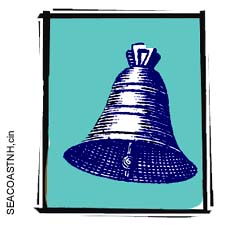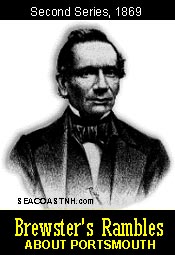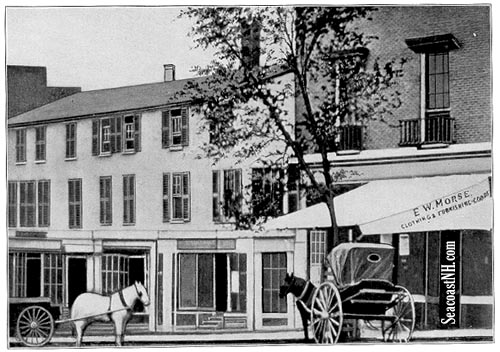| Tales of the Old Bell Tavern |

BREWSTER’S RAMBLES # 143
Brewster spins yarns about a downtown tavern that burned in 1867. Legend says it was the haunt of Revolutionary War patriots, of Johnny Tilton the chicken boy, jailkeeper Ebenezer Chadwick, John Paul Jone’s landlady Sarah Purcell and many others.
RAMBLE CXLIII
The Old Bell Tavern.
Editors Note: See the update at end of article. C.W. Brewster was a Portsmouth, New Hampshire columnist and editor in the early to mid-1800's. This article includes his opinions and may not reflect current research or current values. From Brewster’s Rambles About Portsmouth, 1859 exclusively on SeacoastNH.com. – JDR
 THE old landmarks of a city, if not of great beauty, have an interest which time gives to many things of antiquity. Four or five successive generations have been wont to look upon this old tavern, as one of the matters which formed the hub of the busy wheel of Portsmouth. In the recollections of our older inhabitants, the Court House, the old North Church and the Bell Tavern have an association, together with the Parade and the old oak still standing, which has fixed a lasting picture on the mind.
THE old landmarks of a city, if not of great beauty, have an interest which time gives to many things of antiquity. Four or five successive generations have been wont to look upon this old tavern, as one of the matters which formed the hub of the busy wheel of Portsmouth. In the recollections of our older inhabitants, the Court House, the old North Church and the Bell Tavern have an association, together with the Parade and the old oak still standing, which has fixed a lasting picture on the mind.
They have revolutionary associations. When the patriot Manning on the west Court House steps threw up his hat, declaring that King street should no longer bear that name, but in Congress street should in future the Bell Tavern be found - -from that day the name of the street was changed.
In 1727, the Gains house was built on the west side of the Bell Tavern lot, having a front yard 40 or 50 feet deep. In 1738, a building occupied by Robert Macklin, the baker, who lived to the age of 115 years, was burnt on the present site of Congress Block. Soon after, a portion of the first meeting house was removed to the spot, from the south mill dam, and made a dwelling house for John Newmarch, a merchant. Five years after, in 1743, Paul March, who married a daughter of John Newmarch, built the Bell Tavern.
The building was framed by Hopestill Caswell of New Market, a mulatto, half brother of Paul March. That it was strongly made, the test of a century and a quarter has shown. On the completion of the work there was, according to the custom of the day, a merry gathering to commemorate it. Though Hopestill had performed an important part of the work, he did not venture to approach the board, until it was decided by the company that he should be permitted to come in and partake with them on the joyful occasion.
How long March occupied it, and whether it was at first a public house we know not. An old lady, who saw the house erected, once told us that several years after its erection she had seen the yard filled with hogsheads of molasses, rum, and such goods as showed that March was extensively engaged in mercantile pursuits. Previous to the revolution the house was occupied by Mr. John Greenleaf, and the sign of the Bell (painted blue) was hanging from the post. Whether or not it was intended to represent the "Blue Bells of Scotland," it is not in our power to decide. At that time there was another public house kept by Mr. Foss in the neighborhood, on the spot where the stable of the Franklin House now stands.
CONTINUE to read BELL TAVERN
TALES OF THE BELL TAVERN (continued)
To the old Bell Tavern the patriots of the revolution used to resort, while the tories made their headquarters at the Earl of Halifax. The venerable Theodore Moses of Exeter, has told us that this was the place for resort of such patriots as Thomas Pickering, who commanded the Hampden, and his fellows, and we may well imagine the nature and spirit of the meetings at the bar room and parlors in those days, when punch-bowls were in fashion. Horses were kept at the stable in the rear in those days as now. Mr. Greenleaf's son, on a winter day, was using one of his father's horses and a sleigh for a ride round town. After passing in front of St. John's church, in turning into Bow street, the sleigh went over the bank, where the Day building now stands, and passed down some fifty feet into river. Not much damage was done, excepting a wetting of the horse and driver. It was a perilous adventure.

The keeper after Greenleaf was Fursell (Purcell) whose widow afterwards kept a boarding house in the present residence of Samuel Lord, on Middle street, where John Paul Jones boarded. It was also kept by Col. William Brewster, previous to his occupancy of the house on the site of Richard Jenness' mansion. It was also kept by Mr. Jacob Tilton, the father of the well known idiot Johnny Tilton, who for many years was an inmate of our almshouse. Johnny was not a very bright child, but was not born an idiot. When a boy he was in his father's stable in the rear of the Bell Tavern, and seeing the hens fly out of the loft window, supposed he might do so too. He stood upon the window frame, and flourishing his arms in imitation of the hens' wings commenced his flight -- but he reached the ground rather sooner than he expected, injuring himself so as to affect his mental faculties during his after life. He is well recollected as seen carrying corn to the mill for the almshouse, usually decorated with feathers in his hat, as if in remembrance of the hen adventure. He died about forty years ago. It was he who said, when asked at the mill what he knew, "Some things I know, and some things I don't know -- I know the miller's hogs grow fat, but I don't know whose corn they fat on."
It was afterwards kept by Ebenezer Chadwick, who left it to take charge of the Jail, about 1790. It was afterwards kept for a time by Col. Seth Walker, the Register of Deeds. Early in the present century, Nathaniel Brown, from the Governor's farm in Wolfborough, took charge of the Bell Tavern, and remained there until 1821.
In a letter from a friend who had spent many years under its roof, during Esquire Brown's administration and afterwards, he says:
"It was not a beautiful structure -- an architect would not hold it up as a model. I don't think its proportions are exactly laid down in the books. It had no stately columns, pillars, dome or tower. But it had a history, and hallowed memories which are more significant and enduring. On those walls, in invisible letters perhaps, are written many a legend which if compiled would swell to a volume as large as "Greeley's Conflict," and some of them perhaps quite as thrilling. We had come to think it fireproof. Four times it was enveloped in the flames of its more stately neighbors, and like Moses' bush it consumed not. It had seemed to mourn since the demise of its old companions, the North Church and Court House."
"It was the retreat of a little band of Patriots who used to gather around the midnight lamp, in that quiet ante-room, for the double mission of social improvement and political reform: which latter, was at that time much needed. Sometimes those sessions were continued into the small hours; not from want of harmony, but solely from press of business. Imbued with the spirit of the times, self-denying and earnest, they were bold to do and dare. On its roll were New Hampshire's most honored sons. Sad to say, most of them have passed away. How much of this recent glorious triumph had its germ in that little gathering I will not say. I suppose there may be some mischief-loving persons who as they pass will laugh at its destruction. Well! let them laugh -- so did Nero on another occasion. For one, I shall mourn its loss, and with Mrs. Partington take our cup of tea and recite its story in our own humble way."
To those anniversaries of the "Gilman Blues," where, after the evil spirits the bottles contained had disappeared, the bottles were arranged in a pyramid on the table to be made a target for those who were able to aim a blow at them -- and the appearance of the sedate landlord to know what the "pesky fellows" were doing with his glass ware, -- it would be well to pass over in silence -- and with many other like scenes bury with the ruins of the old tavern.
It will be recollected that here were held the corporation meetings -- here in that front parlor, the probate courts were held for many years. And who will forget that projecting cellar-case door, on the east corner, in front of Pritchard's barber's shop, to which the old truckman Daniel Lowd was daily carried to receive the alms of the public, and the terror he inspired in the school boys at his shrill call for his dog Lion, when they annoyed him as they stopped to gaze.
It has since been kept by Samuel Robinson and Oliver Potter; by Samuel Rea, who changed the structure from a gambrel roof to a three story building. A second Mr. Tilton, Hiram Locke, Jackson & Rowe, and we know not but some others, were the landlords after Mr. Rea.
In 1852, the building was sold to J. P. Morse, Aaron Akerman and Henry M. Clark. The old sign post of the blue Bell was soon cut down, and three stores made in front. Thus it remained, until the fire in March, 1867, swept it away. Nobody is sorry for its departure -- as its place is supplied by the handsome three-story block, an ornament to the city, built by Messrs. Henry M. Clark, Aaron Akerman and Samuel S. Frye.
UPDATES, NOTES & LINKS: For much more on Housewright Hopestill Cheswell and his father Wentworth Cheswell (Brewster says Caswell) see Black Portsmouth. Brewster appears also to refer to Sarah and Gregory Purcell (he says Fursell). This essay appears to be the best known source of the story that John Paul Jones lodged at what is currently the museum of the Portsmouth Historical Society on Middle Street.
Text scanned courtesy of The Brewster Family Network
Copy of Rambles courtesy Peter E. Randall
History Hypertext project by SeacoastNH.com
This digital transcript © 1999 SeacoastNH.com
